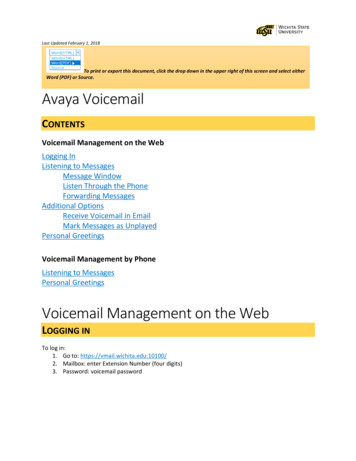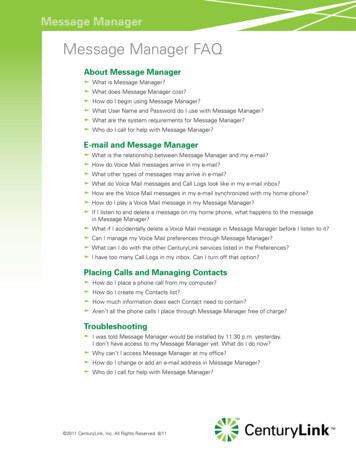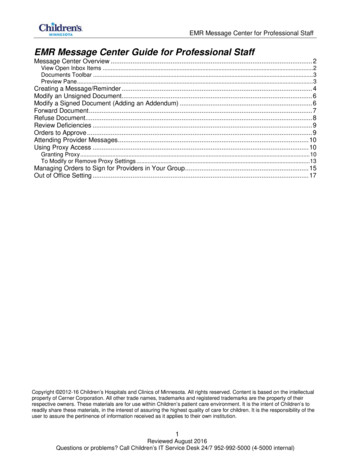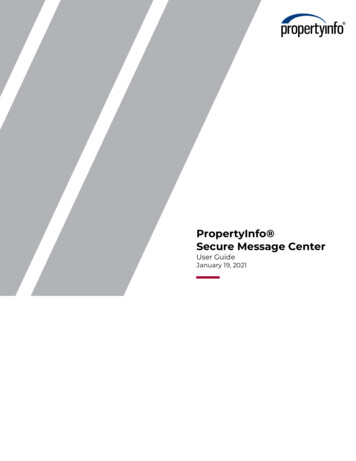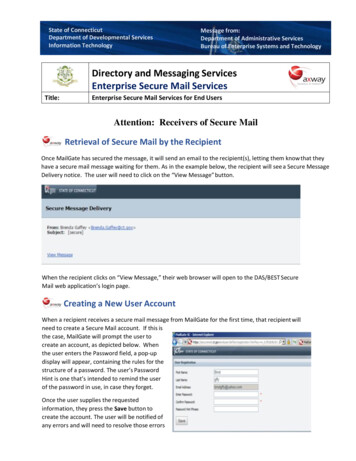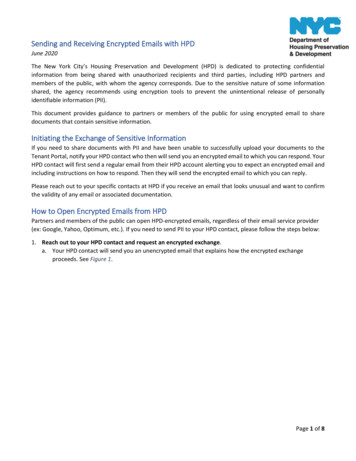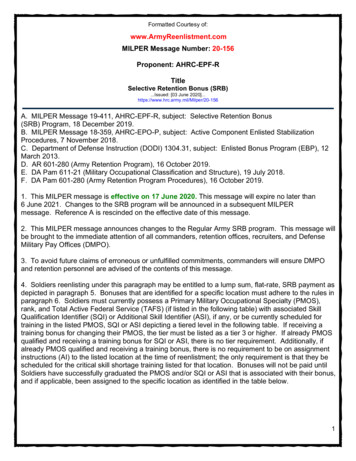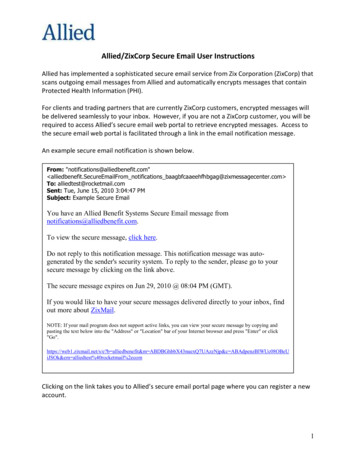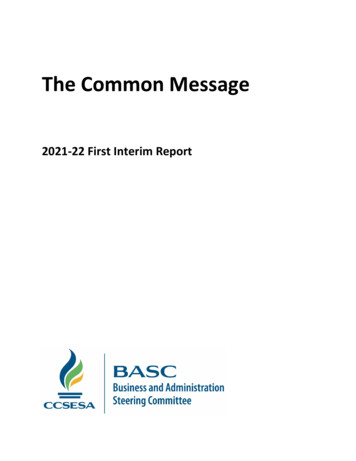
Transcription
The Common Message2021-22 First Interim Report
Writers and mmitteeKey GuidanceMike Simonson, San DiegoDean West, OrangeSignificant Changes Since BudgetAdoptionMike Simonson, San DiegoDean West, OrangeIndependent StudyJanet Riley, MercedKate Lane, MarinForm J-13AJanet Riley, MercedFederal and State Funds (ESSERIII)Priscilla Quinn, KernMary Downey, SonomaNew Plan RequirementsJosh Schultz, NapaShannon Hansen, San BenitoPlanning Factors/MYPShannon Hansen, San BenitoJanet Riley, MercedExpanded Learning Opportunities Kate Lane, MarinProgramLisa Rico, TuolumneLCAPJosh Schultz, NapaNick Schweizer, SacramentoReserves / Reserve CapColleen Stanley, MontereyLiann Reyes, Santa CruzEarly Childhood EducationFernie Marroquin, TulareJanet Riley, MercedSummaryMike Simonson, San DiegoDean West, Orange2 Page
Table of ContentsSources. 4Background . 5First Interim 2021-22 Budget Key Guidance . 5Significant Changes Since Budget Adoption .5Independent Study .6Request for Allowance of Attendance Due to Emergency Conditions: Form J-13A .6Federal and State Funds .7New Plan Requirements .8Planning Factors for 2021-22 and MYPs .8Expanded Learning Opportunities Program .9Local Control Accountability Plan.10Reserves / Reserve Cap .11Early Childhood Education .11Summary . 123 Page
SourcesAssociation of California School AdministratorsBall / Frost Group, LLCBob Blattner and AssociatesBob Canavan, Federal Management StrategiesCalifornia Association of School Business OfficialsCalifornia Collaborative for Educational ExcellenceCalifornia Department of EducationCalifornia Department of FinanceCalifornia Public Employees’ Retirement SystemCalifornia State Teachers’ Retirement SystemCalifornia State Board of EducationCalifornia School Boards AssociationCalifornia School Information ServicesCapitol AdvisorsFiscal Crisis and Management Assistance TeamK-12 High Speed NetworkMichael Hulsizer, Chief Deputy Governmental Affairs, Kern County Superintendent of SchoolsNational Forest Counties and Schools CoalitionSchool Services of CaliforniaSchools for Sound Finance (SF2)Small School Districts’ AssociationStatewide LEC Co-chairsWestEd4 Page
BackgroundThe BASC would like to thank the DOF, the State Board of Education (SBE), the CaliforniaDepartment of Education (CDE) and the Fiscal Crisis and Management Assistance Team, as wellas our colleagues in education listed in the sources section for providing BASC and our localeducational agencies (LEAs) the most up-to-date information at the time of the CommonMessage writing.Purpose: The BASC Common Message is intended as guidance and recommendations to countyoffices of education (COEs). Each COE will tailor the guidance to the unique circumstances ofthe LEAs located in their county. Even within a county, COE situational guidance may varyconsiderably based on the educational, fiscal and operational characteristics of a particulardistrict. Districts and other entities seeking to understand the guidance applicable to aparticular LEA should refer to the information released by the COE in the county where the LEAis located.First Interim 2021-22 Budget Key GuidanceOn June 28, 2021, Governor Gavin Newsom signed an on-time budget. The budget maintainedseveral items that were included in the May Revision: a 5.07% Cost of Living Adjustment (COLA)to the Local Control Funding Formula (LCFF), 4.05% COLA to Special Education, and 1.7% tostate categorical programs; contributions to the Public School System Stabilization Account andrainy day funds; and a legislative workaround to limit spending and maximize exceptions tomaintain the constitutional appropriation Gann Limit. The large funding priorities in thisAdopted Budget are: 11 billion to eliminate interyear principal apportionment deferrals 3.2 billion for 5.07% LCFF mega COLA 1.126 billion for concentration grant increase 1.8 billion for expanded learning time for K-6 unduplicated studentsRequirement for in-person instruction and the availability of independent studyMultiyear ramp up of universal transitional kindergartenPlanning for a universal meal program in 2022-23Significant Changes Since Budget AdoptionAssembly Bill (AB) 167, the education budget cleanup trailer bill, was signed by the Governor onSeptember 23, 2021. The bill includes cleanup language for the following grants: Additional LCFF Concentration Grant funds and the LCAP Supplemental GrantPrekindergarten Planning and Implementation Grant ProgramA-G Completion GrantKitchen Infrastructure Grant5 Page
In addition, AB 167 provides additional time for requests to change grades to Pass/No Passreceived after October 1, 2021. The requirements for this section impose a state-mandatedlocal program.Finally, AB 167 allows substitute teachers to serve in any one assignment for up to 60cumulative days for the 2021-22 school year.Independent StudyOn June 30, 2021, the statutes that established distance learning in Senate Bill (SB) 98 becameinoperative. All of the instructional time and attendance accounting requirements in place priorto fiscal year (FY) 2020-21 are back in effect for FY 2021-22. As in years prior to FY 2020-21,LEAs must meet the requirements of independent study to generate average daily attendance(ADA) for students not scheduled for physical in-person instruction.Although AB 130, the education omnibus budget trailer bill, did not change the method used togenerate a day of attendance for apportionment purposes in independent study, bothtemporary (2021-22 only) and permanent changes to independent study program requirementswere made and are conditions of apportionment.AB 167 clarifies that in lieu of receiving attendance credit through the Form J-13A process forCOVID-19 related school closures or material decreases in attendance, LEAs may serveimpacted students through independent study and claim apportionment pursuant toindependent study requirements. If a school closure is necessitated due to staff shortagescaused by COVID-19, an LEA may still use the J-13A process.AB 167 also clarified that the “teacher of record” for independent study programs may be anemployee of the LEA or the LEA that has been contracted to provide independent study. FAQsabout independent study offering requirements, waivers, instructional time and attendanceaccounting can be found here.In addition, the California County Superintendents Educational Services Association developeda tool kit to help navigate the significant changes to independent study that guides LEAsthrough the process of developing plans, policy, and strategies for tiered re-engagement.Request for Allowance of Attendance Due toEmergency Conditions: Form J-13AAB 130 introduced significant changes to the Request for Allowance of Attendance Due toEmergency Conditions (Form J-13A) for material decreases in attendance and for schoolclosures occurring between September 1, 2021 and June 20, 2022. Chief among the changes isa requirement to submit a plan to provide independent study for school closures lasting inexcess of 10 days with all J-13A requests. CDE has published comprehensive FAQs for LEAs toreference.6 Page
AB 167 amended education code to restrict the J-13A process for attendance credit relative toCOVID-19 related school closures or material decreases in attendance to solely those eventscaused by staff shortages as long as specific requirements delineated in statute are met. LEAsmay still use the J-13A process to request instructional time credit to meet the annual day andminute requirements to avoid audit penalties if LEAs certify to offering independent study to alleligible students during the school closure.Additionally, the J-13A process may be used for COVID-19 attendance losses for school sites orclasses that only serve students who are individuals with exceptional needs and for studentsserved in community day schools. LEAs may claim apportionment attendance through theprovision of independent study for all other COVID-19 related disruptions to in-person learning.LEAs that experienced a COVID-19 related material decrease in attendance or school closureprior to September 1, 2021, can submit a Form J-13A to mitigate losses of ADA and receiveinstructional time credit for ADA losses that occurred on dates prior to September 1, 2021.When a state of emergency has been declared, claims for a material decrease in attendance donot have to exceed the 10% threshold normally required.Federal and State FundsElementary and Secondary School Emergency Relief (ESSER III) FundESSER III Formula AllocationsThe Schedule of Allocations can be found on the ESSER III Funding Results page.The final deadline to submit ESSER III Assurances is December 17, 2021.ESSER III Fund Frequently Asked QuestionsAmerican Rescue Plan (ARP) Act Elementary and Secondary School Emergency Relief (ESSER III)fund FAQs and responses may be found spESSER III Expenditure Plan FAQsARP Act Elementary and Secondary School Emergency Relief (ESSER III) fund Expenditure PlanFAQs and responses may be found spFederal Stimulus ReportingLEAs are required to report on any ARP Act funds they receive. These funds must be trackedand reported separately from CARES Act and CRSSA Act funds. Please visit the CDE FederalStimulus Funding web page for more detailed reporting requirements. Reporting timelines areavailable on the Federal Stimulus Funding Reporting web page. For reporting on the use ofESSER III funds (3213 and 3214), please use the Federal Stimulus Funds Reporting Application.7 Page
Interest Earned on ESSER III Fund: ESSER III Funds are subject to Title 2, Code of FederalRegulations, Part 200.305, which requires grantees and sub-grantees to remit interest earnedon advances to the federal agency. Grantees or sub-grantees may retain interest amounts up to 500 per year for related administrative expenses. For more information, please refer to theCDE web page on Interest Earned on Federal Funds.New Plan RequirementsAB 130 and AB 167 created multiple new planning requirements for the 2021-22 fiscal year. Inaddition to the revised LCAP requirements described in the LCAP section, the following plansmust be developed by LEAs this year:PlanDeadlineRequiredTemplate?ApprovalESSER III Safe Return to InPerson InstructionEvery 6monthsafter initialassurancesYes for initialassurances,no thereafterEducator Effectiveness BlockGrant12/30/21NoA–G CompletionImprovement Grant4/1/22NoPrekindergarten PlanningGrant6/30/22NoPost on websiteAdditionalInformationCDE websitePresent at public boardmeeting, adopt at subsequentboard meetingPresent at public boardmeeting, adopt at subsequentboard meetingBoard adopts at public meetingE.C. 41480E.C. 41590E.C. 8281.5Planning Factors for 2021-22 and MYPsKey planning factors for LEAs to incorporate into their 2021-22 First Interim reporting andmultiyear projections are listed below and are based on the latest information available.Planning FactorCost of Living Adjustment (COLA)LCFF COLASpecial Education COLAStatutory COLA2020-21 COLA recaptured in 48%2.48%2.48%3.11%3.11%3.11%8 Page
Planning Factor2021-222022-232023-24Employer Benefit RatesCalSTRSCalPERS-SchoolsState Unemployment 7.10%0.20% 163 65 163 65 163 65LotteryUnrestricted per ADAProp. 20 per ADAMandated Block GrantDistrictsK-8 per ADA9-12 per ADAChartersK-8 per ADA9-12 per ADA 32.79 63.17 33.60 64.74 34.64 66.75 17.21 47.84 17.64 49.03 18.19 50.55California State Preschool Program (CSPP)Full-day programPart-day program 51.87 32.12 53.16 32.92 54.81 33.94Expanded Learning Opportunities ProgramThe state budget provided 1.8 billion for access to comprehensive expanded learning for allunduplicated students in elementary schools. The intent is to provide before- and after-schoolopportunities that, in combination with the instructional day, total nine hours daily, in additionto 30 expanded learning days during intersession periods. LEAs must maintain a pupil-to-staffmember ratio of no more than 10:1 in programs serving TK & kindergarten age students.AB167 amends Education Code 46120 to add the Expanded Learning Opportunity Program tothe principal apportionment and delays conditions of apportionment until 2022-23. Fundsreceived in 2021-22 may be expended through the 2022-23 fiscal year for developing a programor providing services.Beginning in 2022-23, as a condition of apportionment, expanded learning opportunities mustbe offered to classroom based K-6 students based on the LEA’s UPP as follows:Fiscal YearLEA UPPOffering RequirementProvide Access Requirement2021–22AllAll TK/K–6 classroombased unduplicated pupils50% of TK/K–6 enrolled classroombased unduplicated pupilsCommencing2022–23 80.00%(Higher funding rate)All TK/K–6 classroombased pupilsAll TK/K–6 classroom-based pupilsupon parent/guardian requestCommencing2022–23 79.99%(Lower funding rate)All TK/K–6 classroombased unduplicated pupils50% of TK/K–6 enrolled classroombased unduplicated pupils9 Page
Education Code (EC) Section 46120(d)(4) provides a three year guarantee of the higher fundingrate for LEAs with 80% or greater UPP. This paragraph says that if an LEA qualifies for the higherfunding rate in the current year because their prior year UPP is equal to or above 80%, then theLEA is guaranteed the higher funding rate for three years (the current year plus two moreyears), even if the LEA’s UPP drops below 80% in any of those years. Once the LEA no longermeets the criteria of EC Section 46120(d)(1)(A) (prior year UPP equal to or above 80%) for fourconsecutive years, the LEA will receive the lower funding rate pursuant to EC Section46120(d)(1)(B).The schedule of preliminary entitlements at https://www.cde.ca.gov/fg/aa/pa/elop2122.aspalso identifies the first apportionment equaling 55% of each LEAs entitlement. Futureapportionments will flow through the principal apportionment beginning with P1 certificationand associated exhibits in February 2022.The CDE has also published initial frequently asked questions, which we anticipate will beexpanded as LEAs investigate the programming and infrastructure required to implement thisexpansion of school-based activities.Local Control Accountability PlanNew LCAP requirements come into effect in 2021-22, including: 1) the requirement for a midyear one-time supplement to the annual update, 2) carryover requirements for actions,expenditures, and qualitative improvements contributing to increased and improved servicesfor targeted pupils, and 3) demonstration of how the additional concentration grant add-onfunding is being used to increase the number of staff providing direct services in high needsschools.The template for the supplement will be adopted by the State Board of Education (SBE) inNovember, and LEAs will be required to present the supplement at a regularly scheduled boardmeeting on or before February 28, 2022. The supplement’s contents will be focused on anyLCFF funds that were not included in adopted LCAPs (e.g., additional concentration grant addon, 5.07% COLA) and alignment with other plans.The SBE will also adopt a revised LCAP template in November to reflect all of the newrequirements, including the carryover and additional concentration grant add-on requirements.LEAs should track LCAP and other required plan implementations closely throughout the yearand communicate proactively about the new requirements. Carryover related to the increasedand improved services may be difficult to avoid in some circumstances due to the confluence ofone-time funding and late notice about added LCFF funding. If significant carryover isanticipated, LEAs may want to begin engaging stakeholders sooner rather than later aroundwhy this is the case, and what it means for the future.10 P a g e
Reserves / Reserve CapThe school district reserve cap will be triggered for the first time beginning with the 2022-23Adopted Budget. Small (less than 2,501 ADA) and basic aid districts are exempt from this cap.Districts should plan ahead to ensure they are limiting their assigned and unassigned reserves inthe General Fund 01 and the Special Reserve Fund for Other than Capital Outlay Fund 17 to nomore than 10% of annual expenditures. Funds that are in the committed portion of the fundbalance are not included in the reserve cap calculation; therefore, consider a Board resolutionthat will set aside funds for specific uses. School district boards are further encouraged to adopta formal policy regarding their minimum reserves.Lastly, a county superintendent of schools may grant a school district under its jurisdiction anexemption from the requirements of subdivision (a) in SB 751 for up to two consecutive fiscalyears within a three-year period if the school district provides documentation indicating thatextraordinary fiscal circumstances, including, but not limited to, multiyear infrastructure ortechnology projects, substantiate the need for a combined assigned or unassigned endinggeneral fund balance that exceeds the cap limits.Early Childhood EducationAB 167 established the California Prekindergarten Planning and Implementation GrantProgram. The 300 million total of one-time Prop. 98 funds is allocated as follows: Allocation for 200 million is based on California Longitudinal Pupil Achievement DataSystem (CALPADS) Fall 1 kindergarten enrollment from the 2020-21 certification, asfollows:o For LEAs with an enrollment of: 1 to 23 pupils – base grant 25,000; 24 to 99 pupils – base grant 50,000; 100 or more pupils – base grant 100,000. A minimum base grant for each COE of 15,000 for each local educationalagency in their county that operates kindergarten programs to supportcountywide planning and capacity building. 100 million in one-time funding for competitive grants to increase the number of highlyqualified preschool and TK teachers, as well as provide professional development forpreschool, TK and kindergarten teachers. This can be single districts or a consortia ofLEAs that apply to cover a particular service area.Of the remaining funds after the above allocations: 60% shall be available as enrollment grants. These grants shall be allocated based on theLEA’s proportional share of total CALPADS Fall 1 kindergarten enrollment for the 201920 fiscal year, as applied to the total amount of program funds available for theenrollment grant.11 P a g e
40% shall be available as supplemental grants. These grants shall be allocated based onthe LEA’s CALPADS Fall 1 kindergarten enrollment minus the TK program enrollment forthe 2019-20 fiscal year, multiplied by the LEA’s unduplicated pupil percentage, ascalculated pursuant to subdivision (b) of Section 42238.02 or subdivision (b) of Section2574 certified as of the second principal apportionment.Grant funds may be used for costs associated with creating or expanding California statepreschool programs or TK programs, or to establish or strengthen partnerships with otherproviders of prekindergarten education within the LEA, including Head Start programs, toensure that high-quality options for prekindergarten education are available for 4-year-oldchildren. Allowable costs include, but are not necessarily limited to, planning costs, hiring andrecruitment costs, staff training and professional development, classroom materials, andsupplies.Also included in SB 167 is the California Preschool, Transitional Kindergarten and Full-DayKindergarten Facilities Grant Program. It is established to provide one-time grants to schooldistricts to construct new school facilities or retrofit existing school facilities to provide TKclassrooms and full-day kindergarten classrooms pursuant to Section 8973, and for theconstruction of new preschool classrooms, the modernization of existing preschool classrooms,or the modernization of existing kindergarten and grade 1 to 12, inclusive, classrooms thatwould be converted to provide California state preschool programs operated by school districtson a public school site. In addition, A school district shall not use funds to purchase or installportable classrooms. 490 million is appropriated from the General Fund to the State Allocation Board to provideone-time grants as well as 100 million for the 2018-19 fiscal year.SummaryThis edition of the Common Message serves to provide data and guidance to LEAs for fiscalplanning and the development of their 2021-22 First Interim Report and multiyear projection.The information provided for fiscal year 2021-22 and beyond includes the latest knownproposals and projections to assist with multiyear planning. As each LEA has unique funding andprogram attributes and needs, it remains essential that LEAs continuously assess theirindividual situations, work closely with their county offices of education, and plan accordinglyto maintain fiscal solvency and educational program integrity.12 P a g e
Lottery Unrestricted per ADA Prop. 20 per ADA 163 65 163 65 163 65 Mandated Block Grant Districts . K-8 per ADA . 9-12 per ADA . Charters . K-8 per ADA . . 17. 21 . 47. 84 . 33. 60 . 64.74 . 17. 64 . 4 9.03 . 34. 64 . 66. 75 . 18. 19 . 50. 55 California State Preschool Program (CSPP) Full-day program Part-day program 51.87 .



